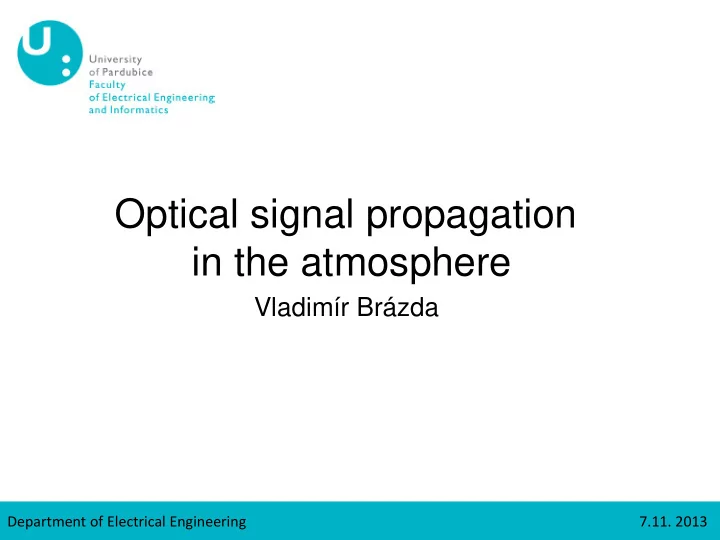

Optical signal propagation in the atmosphere Vladimír Brázda Department of Electrical Engineering 7.11. 2013
INTRODUCTION • Free space optical (FSO) links are used as an alternative to radio links offering very high data rates comparable to optical fibers • However, they are sensitive to local atmospheric conditions • Proper verified models of optical signal propagation in particular phenomena (fog, clouds, rain, snow, atmospheric turbulence etc.) are needed for effective link planning • Nowadays an implementation of ground-to- satellite optical link is being considered. The most critical factor is an attenuation in clouds. • Our experimental site on Milesovka mountain is very often in the centre of clouds – we are able to Milesovka Mt. contribute significantly to this research • Experimental site is a joint workplace of Institute of Atmospheric Physics ASCR and University of Pardubice Department of Electrical Engineering 7.11. 2013 1
OBJECTIVES • Verification and updating of current models of attenuation in particular phenomena (fog, rain, turbulence) • Development of a semi-empirical model of attenuation in clouds • Research of other sources of attenuation such as mechanical vibration of transceivers, effect of sunshine etc. Department of Electrical Engineering 7.11. 2013 2
MATERIAL & METHOD Parameters of the optical link Channel CH2 CH1 Laser diode DL5032 RLT1550-15G Wavelength λ 830 nm 1550 nm Transmitted power P TX 5 mW 7 mW Divergence φ 10 mrad Dynamic range of receiver 45 dB Link length 60 m ≈ 29 ° Elevation angle Meteorological measurements: • Visibility, rain rate, snow rate, liquid water content, particle surface area, 3D wind velocity, temperature, relative humidity, air pressure, height of clouds etc. • Planned measurements: drop size Experimental setup distribution of rain and clouds Department of Electrical Engineering 7.11. 2013 3
RESULTS Dependence on visibility • There is no wavelength dependence in low visibility as expected • Measurement in clouds doesn’t confirm the Kim formula valid for fog. Therefore there is a need to develop a model for cloud Department of Electrical Engineering 7.11. 2013 4
RESULTS Rain impact • The model for rain attenuation by Carbonneau (ITU-R recommendation) is confirmed by our measurement Rain has a minimal impact, specific attenuation causes up to several dB/km • α = ⋅ 0 . 67 1 . 076 R [dB/km] rain Department of Electrical Engineering 7.11. 2013 4
RESULTS We have found a high correlation of attenuation with sonic temperature T is temperature in K , e is the pressure of + e water vapour [hPa], = 1 0 , 32 [ K ] T s T p is the total air pressure [hPa] p Sonic temperature is measured by sonic anemometer and expresses the status of atmosphere from the “clear air” point of view. It reflects the impact of the atmospheric gases (especially water vapor) on the FSO link attenuation Department of Electrical Engineering 7.11. 2013 4
ACKNOWLEDGEMENT & CONTACT Vladimír Brázda vladimir.brazda@student.upce.cz Department of Electrical Engineering Faculty of Electrical Engineering and Informatics University of Pardubice Czech Republic http://www.upce.cz/en/fei/ke.html The research was supported by the grants SGFEI01/2012 and SGFEI01/2013 by IGA of University of Pardubice, GACR grant No. P102/11/1376 and MSMT grant No. LD13036 regarding the COST action IC1101. Department of Electrical Engineering 7.11. 2013 5
Recommend
More recommend